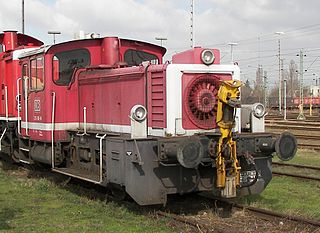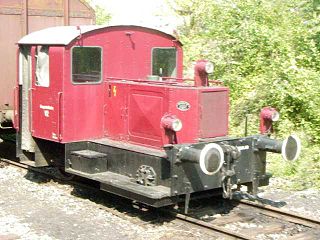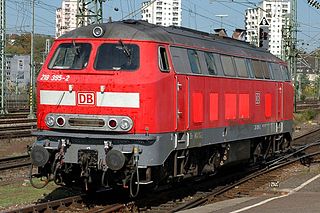History
In order to speed up goods traffic and meet the challenges posed by emerging competition from road traffic, various national railways in Europe carried out trials with small diesel-powered shunters starting in 1923. Until then, all shunting movements for goods wagons at small stations and loading yards had to be carried out by the locomotive in charge of the local goods train (Nahgüterzug). This extended waiting times and reduced the average speed of the train considerably, but having a dedicated shunting engine at such stations would not have been economically viable due to the low levels of goods traffic. The development of combustion-engined locomotives offered new possibilities here: the Kleinlokomotiven were smaller, cheaper and easy to operate. It was anticipated that the resulting improvement in the speed at which goods could be moved would enable railways to compete with road transport.
The first trials - in 1923 by the French Eastern Railway, in 1925 by the Danish State Railway, in 1925 by the Dutch Railways, and in 1927 by the Reichsbahn - were very promising.
As a result, in 1930, the Deutsche Reichsbahn issued the first orders to various manufacturers for a total of 18 trials locomotives. A 1927 shunting unit delivered by the Berliner Maschinenbau AG to the Dutch State Railways served as a prototype. These vehicles were very different from one another, with varying performance. For its subsequent orders, in 1931 and 1932, the DRG specified the dimensions and divided the locomotives into two power categories – locomotives with an engine power output of up to 40 PS (29 kW) were allocated to power group I and more powerful locomotives to power group II. Based on its experience with the earlier engines, the Kleinlokomotiven were then standardised by the DRG as Einheitskleinlokomotive (standard small locomotives).
Classification
DRG classification system
The first Kleinloks to be completed in 1930 were initially given the letter class V for Verbrennungsmotor (combustion engine) or A for Akkumulatorlokomotive (accumulator or battery-driven locomotive) followed by a serial number, beginning at 6000.
To make a better distinction between the various types of Kleinlokomotiven, the Deutsche Reichsbahn (DRG) introduced a new system in 1931, as part of which the concept of a Kleinlokomotive was first unequivocally laid down. Traction engines that only worked in railway workshops or at repair shops ( Ausbesserungswerken ) were not counted as Kleinlokomotiven.
The class letter K was now used to identify them. This was followed by a letter indicating the type of engine: b stood for petrol engine (Benzol, lit: "benzene"), d for steam engine (Dampfmaschine), ö for diesel engine (Öl, i.e. oil) and s for a battery-driven electric engine (Speicher, i.e. accumulator battery). The next letter indicated the type of transmission: e for electric power transmission (Elektrogetriebe) and f for hydraulic transmission (Flüssigkeitsgetriebe). Kleinlokomotiven with purely mechanical transmission were not given a specific third letter and those whose batteries were charged by a diesel or petrol engine were classified as Köe and Kbe respectively.
These letters were followed by a four-figure number, which indicated the power of the Kleinlok. Locomotives in power group (Leistungsgruppe) I were given numbers up to 3999; locomotives in power group II numbers from 4000 onwards. The numbers ran sequentially within each group.
In 1944, the letter g was introduced for locomotives powered by generator gas (Generatorgas).
Like the other DRG classification schemes, the classification for Kleinlokomotiven was retained by the Deutsche Bundesbahn (DB) and the Deutsche Reichsbahn after the Second World War.
In 1955, the Deutsche Bundesbahn raised the boundary between power groups I and II from 40 PS to 50 PS. In 1956, a new power group III was introduced for Kleinlokomotiven with an engine power output over 150 PS and they were allocated operating numbers from 10000 to 20000. In 1960, the Deutsche Bundesbahn changed the code letter s to a.
1968 DB numbering scheme (West Germany)
Beginning on 1 January 1968, Kleinlokomotiven in the DB were placed into new classes in the 300 series. The second figure indicated the power class (based on the 1955 groups). The third digit varied depending on top speed and the type of brake or drive (chain drive or Gelenkwellenantrieb). Ka locomotives were allotted to classes 381 (pre-war types) and 382 (newer types). The existing narrow gauge Kleinlokomotiven on the Wangerooge Island Railway were grouped into Class 329.
In 1987, the DB Class 260/261 diesel locomotive (the pre-1968 Class V 60) was classed as a Kleinlokomotive so that it could be crewed by shunting staff who had not been trained to work locomotives on the open line. They were consequently reclassified as 360/361 engines.
1970 DR numbering scheme (East Germany)
The DR's new numbering plan, introduced on 1 July 1970, placed all existing Kleinlokomotiven into Class 100, i.e. into the standard range of numbers for combustion-engined locomotives. Locomotives in power group I became sub-class 100.0 and locomotives in power group II went into sub-classes 100.1–100.9. The narrow gauge Kleinloks of both power groups were also grouped into sub-class 100.9 until 1972, but were then moved to Class 199.
Prior to 1970, however, newly built Kleinlokomotiven in the DR had not been given the class letter K, but were allocated, for example, to Class V 15 (later 101).
In the DB/DR common numbering scheme of 1992, the DR's Class 100 locomotives became Class 310.

The Deutsche Reichsbahn, also known as the German National Railway, the German State Railway, German Reich Railway, and the German Imperial Railway, was the German national railway system created after the end of World War I from the regional railways of the individual states of the German Empire. The Deutsche Reichsbahn has been described as "the largest enterprise in the capitalist world in the years between 1920 and 1932"; nevertheless its importance "arises primarily from the fact that the Reichsbahn was at the center of events in a period of great turmoil in German history".

The Deutsche Bundesbahn or DB (German Federal Railway) was formed as the state railway of the newly established Federal Republic of Germany (FRG) on 7 September 1949 as a successor of the Deutsche Reichsbahn-Gesellschaft (DRG). The DB remained the state railway of West Germany until after German reunification, when it was merged with the former East German Deutsche Reichsbahn (DR) to form Deutsche Bahn, which came into existence on 1 January 1994.
Originally, both Deutsche Bundesbahn and Deutsche Reichsbahn continued the classification system of the Deutsche Reichsbahn (DRG) – see also a short overview of the numbering system of the German railways. When UIC introduced a new classification system that could be processed by the computers of the late 1960s, DB did a major modification of their system, effective 1 January 1968. This system is still in use and now includes the engines of the former GDR railways as well.
The different railway companies in Germany have used various schemes to classify their rolling stock.

The DRB Class 50 is a German class of 2-10-0 locomotive, built from 1939 as a standard locomotive (Einheitsdampflokomotive) for hauling goods trains. It had one leading axle and five coupled axles and was one of the most successful designs produced for the Deutsche Reichsbahn.

The German Steam Locomotive Museum or DDM is located at the foot of the famous Schiefe Ebene ramp on the Ludwig South-North Railway in Neuenmarkt, Upper Franconia. This region is in northern Bavaria, Germany. The DDM was founded in 1977.

The locomotives of the German DRG Class 81 were standard (Einheitsdampflokomotiven) goods train tank locomotives with the Deutsche Reichsbahn-Gesellschaft (DRG).

German Kleinlokomotiven like the DRG Kö II were developed as locomotives with a low weight and driving power for light shunting duties. There were two classes, based on engine power. The Class II were engines which developed more than 40 HP.
Three different types of German electric goods train locomotive belonged to the Deutsche Reichsbahn's DRG Class E 91. In addition to the standard locomotives (Einheitslokomotive) described below there was also a Prussian class that was given the designation E 913 in 1927.
The DRG locomotive classification system was developed by the German Imperial Railway Company or Deutsche Reichsbahn-Gesellschaft (DRG), which was formed in 1924 following the merger of the German state railways (Länderbahnen) in 1920. A common classification and numbering scheme was needed in order to organise effectively the four hundred or so different steam locomotive classes taken over from the state railways, as well as new locomotives. This process lasted until 1926. Only then was the final renumbering plan fixed.

The DR locomotive classification scheme in East Germany in the initial post-war period used the DRG system, consisting of a class number (Baureihennummer) followed by a serial number (Ordnungsnummer). With the introduction of computerised (EDP) numbers in 1970 as part of the UIC framework, the system was fundamentally changed for the first time.

The DR Class 65.10 was a four-coupled passenger train tank engine operated by the East German Deutsche Reichsbahn (DR) for heavy suburban and commuter services.

The Prussian T 16.1 locomotives were built for the Prussian state railways as goods train tank locomotives about the time of the First World War. Six examples were also procured by the Imperial Railways in Alsace-Lorraine.

The DB Class V 60 is a German diesel locomotive operated by the Deutsche Bundesbahn (DB) and later, the Deutsche Bahn AG, which is used particularly for shunting duties, but also for hauling light goods trains. Seventeen locomotives were bought used by the Norwegian State Railways and designated NSB Di 5. Also the Yugoslav Railways bought used units, and designated them JŽ 734; they were subsequently designated Series 2133 by the Croatian Railways.

The DB railways Köf III class are light two axle shunting locomotives of Deutsche Bahn AG.

The Kleinlokomotiven of Class I were light German locomotives of low weight and power designed for shunting duties. They were placed in service by the Deutsche Reichsbahn (DRG) after trials had been carried out on several prototype locomotives in 1930. The power source for these locomotives was either a diesel or petrol engine.
The Prussian G 8.2 class of locomotives actually incorporated two different locomotive types: one was the Prussian/Oldenburg G 8.2, for which the Deutsche Reichsbahn subsequently issued follow-on orders; the other was the G 8.2 of the Lübeck-Büchen Railway.

The DB V 160 locomotive family comprises several classes of closely related 4-axle diesel-hydraulic locomotives built in the 1960s and 1970s for the Deutsche Bundesbahn which take the family name from the earliest built model: the 'DB Class V 160'.

DR class V 15 and DR class V 23 were diesel locomotives of Deutsche Reichsbahn in the GDR with side-rod drive for light shunting duties.
This page is based on this
Wikipedia article Text is available under the
CC BY-SA 4.0 license; additional terms may apply.
Images, videos and audio are available under their respective licenses.















